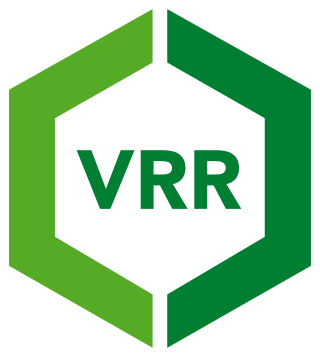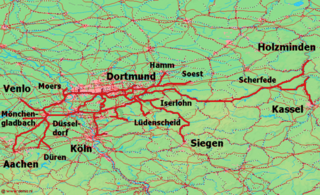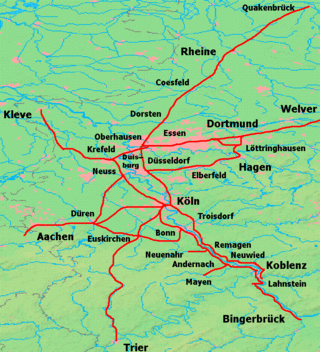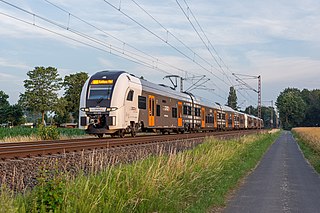
The Ruhr, also referred to as the Ruhr area, sometimes Ruhr district, Ruhr region, or Ruhr valley, is a polycentric urban area in North Rhine-Westphalia, Germany. With a population density of 1,160/km2 and a population of over 5 million (2017), it is the largest urban area in Germany and the third of the European Union. It consists of several large cities bordered by the rivers Ruhr to the south, Rhine to the west, and Lippe to the north. In the southwest it borders the Bergisches Land. It is considered part of the larger Rhine-Ruhr metropolitan region of more than 10 million people, which is the third largest in Western Europe, behind only London and Paris.
The Ennepe-Ruhr-Kreis is a district in the center of North Rhine-Westphalia, Germany. It is part of the southern Ruhr urban area and has ca. 324,000 inhabitants (2012). The district's seat is Schwelm; the largest of its nine towns is Witten.

The Verkehrsverbund Rhein-Ruhr, abbreviated VRR, is a public transport association (Verkehrsverbund) in the German state of North Rhine-Westphalia. It covers most of the Ruhr area, as well as neighbouring parts of the Lower Rhine region, including Düsseldorf and thus large parts of the Rhine-Ruhr conurbation. It was founded on 1 January 1980, and is Europe’s largest body of such kind, covering an area of some 5,000 km2 (1,900 sq mi) with more than 7.8 million inhabitants, spanning as far as Dorsten in the north, Dortmund in the east, Langenfeld in the south, and Mönchengladbach and the Dutch border in the west.

The Bergisch-Markisch Railway Company, also referred to as the Berg-Mark Railway Company or, more rarely, as the Bergisch-Markische Railway Company, was a German railway company that together with the Cologne-Minden Railway and the Rhenish Railway Company was one of the three (nominally) private railway companies that in the mid-19th century built the first railways in the Ruhr and large parts of today's North Rhine-Westphalia. Its name refers to Bergisches Land and the County of Mark.

Witten Hauptbahnhof is a railway station in the town of Witten in western Germany. It is situated southwest of the town.

The Arnsberg Forest Nature Park is a nature park in the districts of Hochsauerlandkreis and Soest within the administrative region of Arnsberg in the German state of North Rhine-Westphalia. The park was established in 1960 and covers an area of 482 km2. Nearly 350 km2 of the protection is forested and the park's wooded hills rise up to 581.5 m above sea level (NN).

The Witten/Dortmund, Oberhausen/Duisburg railway is one of the most important railways in Germany. It is the main axis of long distance and regional rail transport on the east–west axis of the Ruhr and is served by Intercity-Express, InterCity, Regional-Express, Regionalbahn and S-Bahn trains.
The actual boundaries of the Ruhr vary slightly depending on the source, but a good working definition is to define the Lippe and Ruhr as its northern and southern boundaries respectively, the Rhine as its western boundary, and the town of Hamm as the eastern limit.

The Ruhr Valley Railway is a partly abandoned railway line in the German state of North Rhine-Westphalia, running from Düsseldorf-Rath via Old Kupferdreh station, Bochum-Dahlhausen, Witten-Herbede, Hagen-Vorhalle and Schwerte to Warburg. It was built between 1872 and 1876 by the Bergisch-Märkische Railway Company, one of the three major private railway companies in the Ruhr area. The railway tracks that were built along the Ruhr river had a relatively uniform grade that was suitable for railway operations at the time.

Essen West station is situated in Essen on the Witten/Dortmund–Oberhausen/Duisburg railway in the German state of North Rhine-Westphalia. It is served by lines S1, S3 and S9 of the Rhine-Ruhr S-Bahn.
The Düsseldorf-Derendorf–Dortmund Süd railway is a partially closed line in the German state of North Rhine-Westphalia from Düsseldorf-Derendorf station to Dortmund South station. Parts of it are still busy, including two sections used for the Rhine-Ruhr S-Bahn.

Mülheim-Styrum station is located in the district of Styrum in the German city of Mülheim in the German state of North Rhine-Westphalia. It is on the Witten/Dortmund–Oberhausen/Duisburg line and is classified by Deutsche Bahn as a category 3 station.

Essen-Steele Ost station is located in the district of Essen-Steele in the German city of Essen in the German state of North Rhine-Westphalia. It is on the Witten/Dortmund–Oberhausen/Duisburg line and is classified by Deutsche Bahn as a category 4 station. It is served by Rhine-Ruhr S-Bahn lines S 1 and S 3.

Wattenscheid-Höntrop station is a railway station in the district of Wattenscheid of the city of Bochum in the German state of North Rhine-Westphalia. It is on the 97 km-long (60 mi) route of Rhine-Ruhr S-Bahn line S 1 from Dortmund to Solingen. Wattenscheid station, which is more than a kilometre to the northwest is only served by regional trains.

The Osterath–Dortmund-Süd railway is a historically significant line in the German state of North Rhine-Westphalia. Parts of it are closed, much of it is now used for freight only, but several sections are still used for Regional-Express, Regionalbahn or Rhine-Ruhr S-Bahn services.

Essen-Eiberg station is a station in the district of Eiberg of the city of Essen in the German state of North Rhine-Westphalia. It is on the Witten/Dortmund–Oberhausen/Duisburg railway.

The Rhine-Ruhr Stadtbahn is an umbrella system of all of the Stadtbahn lines included in the integrated public transport network of the Verkehrsverbund Rhein-Ruhr (VRR), which covers the Rhine-Ruhr metropolitan area in western Germany. It does not include the Cologne and Bonn Stadtbahn systems, which are integrated in the Verkehrsverbund Rhein-Sieg (VRS).
The Bochum–Essen/Oberhausen railway was built by the Bergisch-Märkische Railway Company to the north of its main line through the central Ruhr to tap traffic from mines and factories in the northern Ruhr region, which is now in the German state of North Rhine-Westphalia.

Rhein Ruhr Express is a regional rail system in the Rhine-Ruhr metropolitan region of Germany connecting the Ruhr Valley and the central Rhineland. The primary goal is to provide a fast connection on the main trunk line between Dortmund and Cologne, located along the Ruhr Valley, with trains every quarter of an hour. This main line has been expanded, improved or reconfigured to enable more trains to operate and at higher speeds. Like the previous Regional-Express lines they replaced, RRX routes branch off from the main trunk line to serve other cities and states at lower frequencies.


















